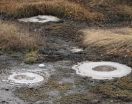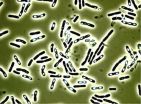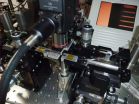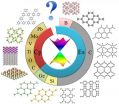INFORMATION:
Original Publication:
Beulig F et al. Carbon flow from volcanic CO2 into soil microbial communities of a wetland mofette, The ISME Journal (2015) 9, 746-759, doi:10.1038/ismej.2014.148
Contact:
Prof. Dr. Kirsten Küsel, Felix Beulig
Institut of Ecology
Friedrich Schiller University Jena
Germany
Dornburger Straße 159, D-07743 Jena
Phone: ++ 49 3641 949461, ++49 3641 949464
Email: kirsten.kuesel@uni-jena.de, felix.beulig@uni-jena.de
Life for specialists: In the poisonous breath of sleeping volcanos
Researchers of the University Jena analyze the microbial community in volcanically active soils
2015-04-01
(Press-News.org) Jena (Germany) The "Villa trans lacum" at the eastern shore of the Laacher See (lake) in the volcanic part of the Eifel - a rural landscape in Germany - was a highly dangerous place. In the 19th century the Jesuit order bought the abbey Maria Laach and built a villa at the shore of the lake. This is where the friars congregated to pray far away from everyday life. But numerous Jesuits paid with their lives for the religious beliefs in the villa. Between 1864 and 1888 17 of them died in the building - literally in their sleep.
"The monks possibly died of carbon dioxide emssions, coming up from the ground at the eastern shore of the lake in large quantities, which could, over time accumulate in the building," as Prof. Dr. Kirsten Küsel of the Friedrich-Schiller Universiy Jena, explains the mysterious series of deaths. The lake is the crater of a volcano which last erupted about 12,000 years ago, reports the chair of Aquatic Geomicrobiology, "and up to now there are traces of volcanicity, which we regularly analyze on a yearly basis in an outdoor seminar in the degree course Biogeosciences." Hints of volcanism are given by so-called mofettes. These are small openings in the ground, leaking carbon dioxide, which originates in the magma chambers of the earth's mantel or the earth's crust.
Small wonder then, that mofettes were places that are supposed to be very hostile to life. However, as the team of researchers around Prof. Küsel was able to demonstrate in a new study: there is life even there, although hidden underground. In a mofette close to the Czech river Plesná in north-western Bohemia the researchers followed the path of the carbon dioxide along its last few meters through the ground up to the surface and found numerous organisms that were thriving in this environment which seems to be so hostile to life. The Jena scientist have just published their findings in the magazine of the "International Society for Microbial Ecology" (DOI: 10.1038/ismej.2014.148).
"Our investigation was aiming at examining microbial communities of a mofette and to find out if organisms profit from carbon dioxide emissions, and if so, which." Felix Beulig from Küsels team says. "We could show, that the carbon dioxide degassing from the interior of the earth is being absorbed by a number of groups of microorganisms and is being transformed into biomass and in chemical bonds like methane and acetic acid. These in turn offer the basic food resource for other organisms in the mofette, and that is why the emitting carbon dioxide plays an important role in the carbon cycle of the soil," the postgraduate student and first author of the study points out.
However, the new study shows that the biodiversity in a mofette is far less than that found in comparable soils. "But we are not dealing with a environment that is so hostile to life as seems to be the case above ground", Kirsten Küsel sums up and reports, that there are habitually dead birds, mice and other small animals around mofettes, and only a few plants defy the "poisonous breath of the sleeping volcanos".
Apart from these elementary findings about the carbon cycle in the soil, the research results of the Uni Jena can be useful in the long run to forecast the potential impact of unwanted degassing from underground carbon dioxide storage ("Carbon Capture and Storage"-technology) and to estimate possible future risks.
ELSE PRESS RELEASES FROM THIS DATE:
A multi-faceted poison
2015-04-01
This news release is available in German.
The Bacillus cereus bacteria is one of the potential causes of food poisoning. Indeed, a recent study in Analytical and Bioanalytical Chemistry shows that this versatile pathogen produces 19 different variants of a poison that causes nausea and vomiting in human beings. This variety could explain why some cases are relatively benign and others can result in death.
Across Europe, the number of food poisoning cases caused by the Bacillus species is on the rise. While unpleasant, infections resulting from B. cereus are usually ...
Diversity prevents resistance
2015-04-01
Our opponents always seem to be one step ahead. Although pest controllers now have numerous chemical preparations available, allowing them to take action against unwanted insects, the species targeted are developing a resistance against the different active substances at a rapid pace. Often a single change in the organisms' genetic material is enough to do this. This means that scientists know more than 500 pests all over the world currently able to resist a total of 300 different insecticides. Many disease-transmitting mosquitoes defy any attempts to control them just ...
Quantum teleportation on a chip
2015-04-01
The core circuits of quantum teleportation, which generate and detect quantum entanglement, have been successfully integrated into a photonic chip by an international team of scientists from the universities of Bristol, Tokyo, Southampton and NTT Device Technology Laboratories. These results pave the way to developing ultra-high-speed quantum computers and strengthening the security of communication.
Qubits (quantum bits) are sensitive quantum versions of today's computer 0's and 1's (bits) and are the foundation of quantum computers. Photons are particles of light and ...
Barriers found that prevent Ugandans with RHD from receiving needed penicillin
2015-04-01
Penicillin has nearly eradicated rheumatic heart disease (RHD) in the United States. But 15 million people still suffer with the disease worldwide, and 1.4 million die each year, according to World Heart Federation.
Access to penicillin can prevent deaths from RHD. Researchers from Case Western Reserve University, Makerere University and the Uganda Heart Institute at Mulago Hospital, a national referral hospital in Kampala, collaborated to learn about those obstacles to receive the medication and find ways to overcome them.
The researchers heard from some Ugandans ...
Accountancy ambitions
2015-04-01
The media is littered with celebrity trainers, bakers, nutritionists, even gardeners. But, one profession is always missing from the roster - the celebrity accountant. The reason is most likely due to the negative stereotypes propagated for centuries. However, this is no bad thing, according to researchers in Australia who suggest in the International Journal of Critical Accounting, that stock characters entrenched in popular culture provide professional stability.
Frances Miley of the University of New South Wales and Andrew Read of the University of Canberra, Australia, ...
3-D neural structure guided with biocompatible nanofiber scaffolds and hydrogels
2015-04-01
Damage to neural tissue is typically permanent and causes lasting disability in patients, but a new approach has recently been discovered that holds incredible potential to reconstruct neural tissue at high resolution in three dimensions. Research recently published in the Journal of Neural Engineering demonstrated a method for embedding scaffolding of patterned nanofibers within three-dimensional (3D) hydrogel structures, and it was shown that neurite outgrowth from neurons in the hydrogel followed the nanofiber scaffolding by tracking directly along the nanofibers, particularly ...
Researchers identify 'beige' fat-burning cells in humans
2015-04-01
For the first time, a research team, led by a UC San Francisco biologist, has isolated energy-burning "beige" fat from adult humans, which is known to be able to convert unhealthy white fat into healthy brown fat. The scientists also found new genetic markers of this beige fat.
The discovery is an important advance in the search for new medications to fight obesity, said senior investigator Shingo Kajimura, PhD, UCSF assistant professor of cell and tissue biology, with a joint appointment in the UCSF Diabetes Center and the Eli and Edythe Broad Center of Regeneration ...
Two-dimensional dirac materials: Structure, properties, and rarity
2015-04-01
Graphene, a two-dimensional (2D) honeycomb sheet composed of carbon atoms, has attracted intense interests worldwide because of its outstanding properties and promising prospects in both basic and applied science. The great development of graphene is closely related to the unique electronic structure, that is, Dirac cones. The cone which represents linear energy dispersion at Fermi level gives graphene massless fermions, leading to various quantum Hall effects, ultra high carrier mobility, and many other novel phenomena and properties.
Dirac cone is special but might ...
Agricultural contaminant impacts fish reproductive behavior
2015-04-01
A common growth-promoting hormone used worldwide in the cattle industry has been found to affect the sexual behaviours of fish at a very low concentration in waterways - with potentially serious ecological and evolutionary consequences.
Researchers from Monash University, in collaboration with researchers from Åbo Akademi University in Finland, have found that the steroid 17β-trenbolone - used on livestock to increase muscle growth - alters male reproductive behaviour in guppy fish (Poecilia reticulata).
This androgenic growth promoter is part of a group ...
Atmospheric energy escaped from the Tibetan Plateau
2015-04-01
The increase of green-house gases in the atmosphere reduces outgoing radiation and thus causes global warming. About 93% extra energy trapped by the greenhouse gases is stored in oceans and only 1% is used to heat the atmosphere. As a main reservoir of heat sink, Oceans are slowing down the global warming magnitude by absorbing the extra energy.
Global warming hiatus was observed since 1998, but the Tibetan Plateau (TP) (also known as the Third Pole) is still undergoing significant warming. Meanwhile, the thermal forcing over the TP, which is a well-known driver of the ...
LAST 30 PRESS RELEASES:
Eye for trouble: Automated counting for chromosome issues under the microscope
The vast majority of US rivers lack any protections from human activities, new research finds
Ultrasound-responsive in situ antigen "nanocatchers" open a new paradigm for personalized tumor immunotherapy
Environmental “superbugs” in our rivers and soils: new one health review warns of growing antimicrobial resistance crisis
Triple threat in greenhouse farming: how heavy metals, microplastics, and antibiotic resistance genes unite to challenge sustainable food production
Earthworms turn manure into a powerful tool against antibiotic resistance
AI turns water into an early warning network for hidden biological pollutants
Hidden hotspots on “green” plastics: biodegradable and conventional plastics shape very different antibiotic resistance risks in river microbiomes
Engineered biochar enzyme system clears toxic phenolic acids and restores pepper seed germination in continuous cropping soils
Retail therapy fail? Online shopping linked to stress, says study
How well-meaning allies can increase stress for marginalized people
Commercially viable biomanufacturing: designer yeast turns sugar into lucrative chemical 3-HP
Control valve discovered in gut’s plumbing system
George Mason University leads phase 2 clinical trial for pill to help maintain weight loss after GLP-1s
Hop to it: research from Shedd Aquarium tracks conch movement to set new conservation guidance
Weight loss drugs and bariatric surgery improve the body’s fat ‘balance:’ study
The Age of Fishes began with mass death
TB harnesses part of immune defense system to cause infection
Important new source of oxidation in the atmosphere found
A tug-of-war explains a decades-old question about how bacteria swim
Strengthened immune defense against cancer
Engineering the development of the pancreas
The Journal of Nuclear Medicine ahead-of-print tip sheet: Jan. 9, 2026
Mount Sinai researchers help create largest immune cell atlas of bone marrow in multiple myeloma patients
Why it is so hard to get started on an unpleasant task: Scientists identify a “motivation brake”
Body composition changes after bariatric surgery or treatment with GLP-1 receptor agonists
Targeted regulation of abortion providers laws and pregnancies conceived through fertility treatment
Press registration is now open for the 2026 ACMG Annual Clinical Genetics Meeting
Understanding sex-based differences and the role of bone morphogenetic protein signaling in Alzheimer’s disease
Breakthrough in thin-film electrolytes pushes solid oxide fuel cells forward
[Press-News.org] Life for specialists: In the poisonous breath of sleeping volcanosResearchers of the University Jena analyze the microbial community in volcanically active soils




